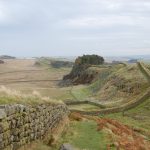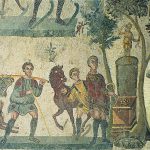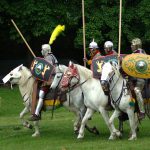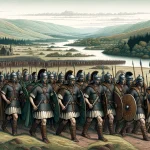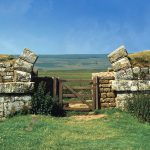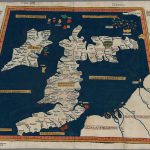Burrow Walls (Magis) Roman Fort
Western Sea Defences
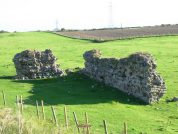
The Burrow Walls fort forms a part of the ‘Western Sea Defences’, a line of forts and watch-towers strung along the north-western coastline of Cumbria from Bowness-on-Solway perhaps as far as Ravenglass, in effect a western extension of Hadrian’s Wall.
Only slight earthwork remains consisting of traces of spread ditch are visible on the south east side and at the east corner. Excavation revealed it to be a typical 2nd century AD fort with evidence for a possible smaller fort within the original banks. It was double ditched with inner bank, and a later ditch inside the latter giving evidence for a smaller fort within the original banks.
However, only 4th century AD pottery was found. Part of the fort circuit and inner ditch are also visible as earthworks on air photographs mapped as part of the North West Coast Rapid Coastal Zone
The Notitia Dignitatum Entry for Magis
Numerus Pacensium – The Company of Pacenses
Praefectus numeri Pacensium Magis
“The prefect of the Company of Pacenses [at] Magis“
(Notitia Dignitatum xl.29; 4th/5th C.)
The sole reference for the name of the Burrow Walls Roman fort is the Notitia Dignitatum of the fourth/fifth centuries, wherein the entry Magis can be found, between the entries for Old Carlisle (Maglona) Roman Fort and Lanchester (Longovicium) Fort ; as one can appreciate, the association is tentative, to say the least.
Pacensis was the southernmost region of the Roman province of Lusitania, the area now corresponding to south Portugal which includes the modern capital Lisboa or Lisbon, in Roman times named Olisipo. The numerus was an irregular auxiliary unit of fairly small size, often part-mounted and usually armed with the traditional weapons peculiar to the tribe from which the unit was levied. The prefect in charge of the unit would probably have been a Roman career soldier, and not a native of Lusitania.
Other Epigraphic Evidence for Magis
Only two inscriptions on stone have been uncovered from the Burrow Walls fort, the texts of both are shown here; for what good they are.
RIB 806 - Fragmentary dedication
… and for their children, Aurelius and Secundus ..
D[6]
COII [...]
ET FILIS EO
RVM AVRE
LIVS ET SECV
[...]DVS MISC[.]
[...]
From Bruce’s figure Huebner interprets as a line of lettering the decoration on the plinth below the die and on the right side.To judge by the height of the figures sculptured on either side, about three lines of text have been lost above extant l. 1 R.P.W.
RIB 807 - Inscription
No translation
No commentary.
References for Magis
- The Roman Inscriptions of Britain by R.G. Collingwood and R.P. Wright (Oxford 1965);
Map References for Magis
NGRef: NY0030 OSMap: LR89
Roman Roads near Magis
military road: NNE (5) to Maryport (Alauna) Roman Fort Probable Military Road: S (6) to Parton (Gabrosentum) Roman Fort (Moresby, Cumbria)
Sites near Burrow Walls (Magis) Roman Fort
- Maryport (Alauna) Roman Fort (8 km)
Hadrianic Auxiliary Fort (117 to 138) - Maryport Temples (8 km)
Temple Or Shrine - Maryport (Alavna) Vicus (8 km)
Vicus - Parton (Gabrosentum) Roman Fort (9 km)
Hadrianic Auxiliary Fort (117 to 138) - Gabrosentum (Parton) Vicus (9 km)
Vicus - Papcastle (Derventio) Roman Fort (11 km)
Flavian Auxiliary Fort (AD 69–96) - Papcastle (Derventio) Vicus (11 km)
Vicus - Western Sea Defences - Milefortlet 21 - Swarthy Hill (12 km)
Western Sea Defences - Beckfoot (Bibra) Roman Fort (21 km)
Western Sea Defences - Caermote Roman Fort (21 km)
Trajanic Auxiliary Fort (A.D. 98–117)
